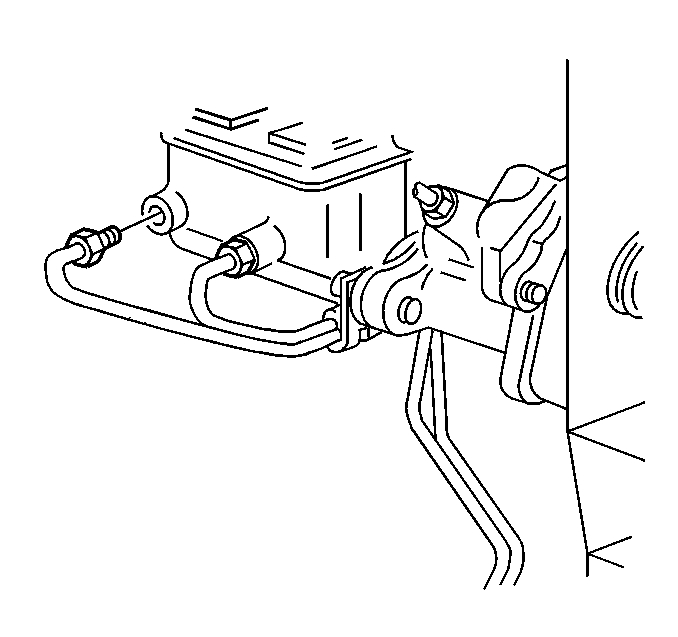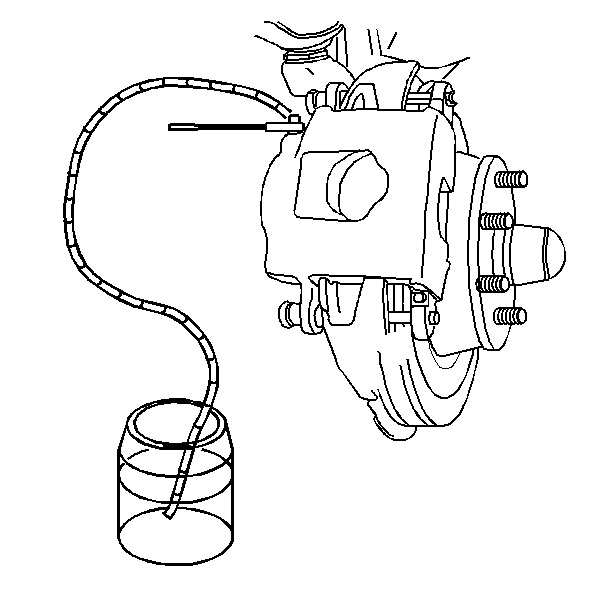If air has entered the hydraulic brake system, bleed the
system. Bleed the hydraulic brake system at all wheels under any of the following
conditions:
| • | Air entered the system due to a low fluid level. |
| • | The brake pipes have been disconnected at the master cylinder. |
| • | The brake pipes have been disconnected at the combination valve. |
If a pipe is disconnected at one wheel, only bleed that wheel.
If the master cylinder has been removed, bleed the master cylinder before
installing it on the vehicle. This will reduce the time required to bleed
the system. Refer to
Master Cylinder Bench Bleeding
.
Notice: Brake fluid will damage electrical connections and painted surfaces.
Use shop cloths, suitable containers, and fender covers to prevent brake fluid
from contacting these areas. Always re-seal and wipe off brake fluid containers
to prevent spills.
Manual Bleeding

- Fill the master cylinder reservoir. Use Delco
Supreme 11® Hydraulic Brake Fluid GM P/N 1052535,
or equivalent DOT 3 motor vehicle brake fluid.
Maintain the fluid level during bleeding.
- If the master cylinder has air in the bore, bleed the master cylinder
using the following procedure:
| 2.1. | Disconnect the forward brake pipe fitting at the master cylinder. |
| 2.2. | Allow the brake fluid to flow from the fitting port. |
| 2.3. | Connect the brake pipe fitting. Do not tighten the brake pipe
fitting. |
| 2.4. | Slowly apply the brake pedal. Allow the air to bleed from the
loose fitting. |
| 2.5. | Tighten the fitting before releasing the brake pedal. |
| 2.6. | Release the brake pedal. |
| 2.8. | Repeat this sequence, including the 15-second wait, until all
the air from the master cylinder bore is eliminated. |
| 2.9. | Repeat this procedure for the rear brake pipe after all the air
from the forward pipe connection is eliminated. |
- Bleed the brakes in the following sequence:

- Attach a hose to the caliper
bleeder valve.
- Immerse the opposite end of the hose into a container partially
filled with clean brake fluid.
- Slowly apply pressure to the brake pedal one time and hold.
- Loosen the bleeder valve in order to eliminate the air from the
caliper.
- Tighten the bleeder valve.
- Slowly release the brake pedal.
- Wait 15 seconds.
- Repeat this sequence, including the 15 second wait, until
all the air from the caliper is eliminated.
- Repeat steps 4-11 at each wheel until all the air from
the brake system is eliminated.
- Check the brake pedal for sponginess. Check the brake warning
lamp for an indication of unbalanced pressure. Repeat the bleeding procedure
in order to correct either of these conditions.
Pressure Bleeding
Tools Required
Use a diaphragm-type pressure bleeder. The pressure bleeder must have
a rubber diaphragm between the air supply and the brake fluid. This prevents
air, moisture, oil and other contaminants from entering the brake hydraulic
system.

- Fill the
pressure tank at least 2/3 full of brake fluid.
- Bleed the bleeder valve each time you add fluid.
- Charge the bleeder to 140-170 kPa (20-25 psi).
- Bleed each caliper in the following sequence:
| 4.3. | Right front caliper. |
- Connect the hose from the bleeder to the adapter at the master
cylinder.
- Open the tank valve.
- Attach a hose to the bleeder valve.

- Attach a hose to the brake
bleeder valve.
- Immerse the opposite end of the hose into a container partially
filled with clean brake fluid.
- Slowly open the bleeder valve at least 3/4 of a turn. Allow the
fluid to flow until you see no air in the fluid.
- Close the bleeder valve.
- Repeat steps 9-11 at each wheel.
- Check the brake pedal for sponginess. Repeat the bleeding procedure
if the brake pedal is spongy.
- Remove the J 29532
.
- Disconnect the hose from the bleeder adapter.
- Remove the J 33855
.
- Fill the master cylinder to the proper level. Refer to
Master Cylinder Reservoir Filling
.




